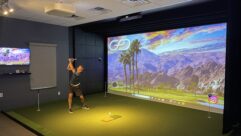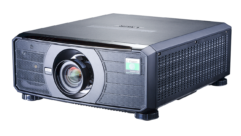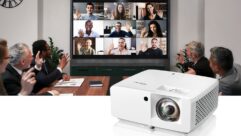With Projectors, What is Bright?
Brightness has long been among most the important specifications used to separate one projector from the litany of others. But by some accounts, it may be reaching the end of its hype cycle, especially as some manufacturers are able to generate bright images at far lower costs.
Brightness has long been among most the important specifications used to separate one projector from the litany of others. But by some accounts, it may be reaching the end of its hype cycle, especially as some manufacturers are able to generate bright images at far lower costs. So what’s the proper place for projector brightness in the daily work of pro AV installers?
“As a rough guide, it still has merit, but it’s only a first-level indication of what you’re going to get for performance,” says Chris Chinnock, president of consulting fi rm Insight Media.”You have to look at the screen technology and the ambient light.”
REDEFINING BRIGHTNESS
Even as a rough guide, traditional brightness standards are less standard than they once were. But brightness itself, especially in pro AV applications, remains important, which is why so many interested parties continue to try and define it.
ANSI lumens, a measure of perceived light determined by testing procedures published by the American National Standards Institute, is still the de facto industry standard, but it has not been without critics and recently ANSI opted not to recertify the standard itself.
“It’s more common in the industry and most people are still associating that standard with light output,” says Corwin Hamm, consultant liaison manager at Barco, a high-end projector maker.”I personally don’t think it’s an effective gauge. It was prevalent in the CRT days.”
Hamm says that although ANSI made the previous standard for lumens fairer by requiring measurements in nine zones of a screen, rather than just the brightest spot, it still didn’t quite capture brightness uniformity, a more useful measure of quality. For its part, Barco employs two measures: center lumens, which shows the maximum brightness of a projector and is important in video, an application in which the eye tends to focus on the middle of the screen; and ANSI lumens, with its more distributed measurements, which are useful in data-intensive applications such as spreadsheets.
But there are others trying to redefine projector brightness measurements. Makers of projectors based on 3-chip liquid crystal display (3LCD) technology, one of the two main projector technologies, are pushing color luminance as an additional standard. They claim vendors of projectors based on rival technology digital light processing (DLP) boost ANSI lumens by adding a fourth, white segment to the color wheels in single-chip DLP, at the expense of the color segments.
“They’re charging more for brighter whiteness but lower color brightness, and the customer doesn’t have a clue,” says Tim Anderson, senior product marketing manager for 3LCD, a consortium.”We can no longer use the brightness specifi cations as a metric for color performance.” Anderson was unwilling to hazard a guess on when color luminance will become a standard, but notes that 3LCD manufacturers have begun measuring and publishing their own numbers in spec sheets.
DLP manufacturers, not surprisingly, won’t be jumping on the bandwagon, which means separating apples and oranges may get harder, rather than easier. DLP proponents insist their technology is brighter and truer across the spectrum, which may be refl ected in the market segments it serves. Pricey, three-chip DLP dominates in digital cinema, claiming 99 percent-plus market share, and DLP is coming on strong in home theater, while LCD continues to hold its own in home theater and in down-market business use in conference rooms, where is its main rival is single-chip DLP.
DLP proponents say thats because the technology refl ects light from millions of microscopic mirrors, it loses less light than LCD, a transmissive technology that reduces the lamp’s brightness by passing it through both LCD panels and light-polarizing color filters.
For AV professionals, there’s no substitute for the naked eye and a client’s case-by-case projection needs in helping determine optimal brightness. After all, the brightness you require depends on a host of variables, from application to ambient lighting. And brightness itself may not always be the most important measure of quality.
THE TOTAL PICTURE
Still, Hamm says that for installers to truly optimize brightness they must get a handle on the effect of three types of light sources on a projected image: ambient, controlled, and uncontrolled.”Those things have the biggest infl uence on the image’s perceived brightness,” he says.”Keep the ambient and uncontrolled light to its absolute minimum.”
Moreover, AV design experts say it’s important to focus on the user experience created by the entire room system than to obsess over numbers. Basic distance and screen-sizing calculators, long available from vendors and consultants, provide some guidance on brightness.
“A lot of these are really old design parameters,” says Tim Cape, principal consultant at Technitect and a Pro AV editorial advisor. For example, the height of the projected image should be eight times the distance to the furthest viewer, but PowerPoint images should be six times that distance- four times for more detailed images such as spreadsheets. Sight lines should allow every viewer to see the entire screen; the rule of thumb says the closest viewer should never be closer than the height of the image. These parameters determine the seating in the room, according to Cape, and impact the end user’s perception of projection brightness.
Greg Jeffreys, director and chairman of U.K.-based Paradigm Audio Visual, has long studied the art and science of light, focusing mostly on rear-projection technology for boardrooms and simulators. His white paper,”Specifying and Assessing Projected Image Quality,” provides practical, indepth advice on the art and science of brightness.
“You actually can’t see ambient light because it’s traveling through the air,” Jeffreys says.”You can’t see it till it strikes a surface.” Lumens, he says,”is a way of describing light that comes from a projector, but it has limited use. When you think about it, you could only experience it if you looked into the projector itself?and it would blind you.”
Instead, the concepts in Jeffreys’ toolbox are luminance (the light reflected or emitted from such objects as walls, furniture, and screens) and illuminance, a synonym for ambient light. People only see luminance; brightness, he says, is a general impression or experience of light, not a measurable phenomenon.
That said, installers often find the cheapest way to reach optimal conditions is to upgrade to brighter projectors rather than fuss with drapes and other environmental controls. More and more, clients want to see what’s on a screen without dimming any lights, and in rooms ill suited to projection applications. Therefore more raw brightness may be what’s specified.
“You can add $500 to a projector, and it can have the extra light to overcome those conditions,” says Mitch Rauch, associate vice president for pro AV and home theater at BenQ USA, a manufacturer pushing into affordable, high-brightness projectors. BenQ recently launched a dual-lamp, single DLP chip-based projector that puts out 6,000 lumens for under $4,500, a signifi cant milestone in bang-for-your-buck brightness.
Not to be outdone, the LCD camp got a shot in the arm in June when Sanyo added a fourth LCD panel to help control yellow light while also increasing the lumen output of its new PLC-XP200L projector. At 7,000 lumens, it’s certainly bright, but it also logs in at $9,995.
HE SAID, HE SAID
How else to get at the crux of your projector brightness needs? How about approaching the equation from a”green” perspective? A 3LCD analysis of specifi cations for 415 projectors tracked by ProjectorCentral.com showed LCD models put out 13.6 lumens per lamp watt, versus 11.26 for DLP models.
“That’s about a 20 percent impact when you look at the effi ciency of the lamps and the actual available light coming out of the projector,” Anderson says.”If you have to use a higher-wattage lamp to get the same lumen output, you’re expending more electricity and putting out higher exhaust temperatures.” The same analysis of Projector- Central.com data showed the average LCD warranty, which Anderson claims is a proxy for reliability, is 33 months, compared to 24 for DLP. But even that comparison is bound to change?at June’s InfoComm 2008, Texas Instruments announced it had extended the warranty on its single-chip projection DLP modules to five years.
Moreover, DLP reportedly outperforms LCD in another quality indicator — brightness uniformity — scoring in the 90 to 95 percent range, according to Hamm, versus 85 percent for LCD.
In the end, though, it might not matter – at least not as much. Much of the buzz nowadays concerns contrast ratio, the relative brightness of blacks and whites in the image.”Some people say it’s the most important,” Cape says.”It’s certainly the one that is compromised the most often” by vendors. While some vendors tout contrast ratios in the thousands, conventional wisdom among installers says the minimal ratio should be 10:1, Cape says.”It sounds small, but in practice, that 10:1 is actually an image that looks pretty good.”
Hamm says other AV consultants put the ratio considerably higher, using 50:1 as sufficient for data images and the bare minimum for video, with 100:1 for excellent video. He says Barco recently applied these rules of thumb to advise the Georgia Aquarium when it wanted to improve the brightness of images projected onto a mosaic tile wall in an atrium.
With ambient light varying wide-ly throughout the day, the previous 5,000-lumen projectors from assorted manufacturers, some even”doublestacked” to create overlaid images and boost brightness, had proved inadequate. After explaining the challenges of the less-than-ideal screen surface, Barco used naked-eye demonstrations, not the readings of light meters, to demonstrate the benefi t of doubling the output to 20,000 lumens but keeping the contrast ratio reasonable, Hamm says.
Rauch agrees that lower-than-advertised contrast is usually satisfactory to viewers.”If they knew that 650:1 in the movie theater makes them happy, what’s a million to one?” he says.”It’s a numbers game. If you’re at 2,000:1, you’re great.”
Jeffreys says ambient light is the real determinant of contrast. While the brightness of the white segment — the top half of the ratio — is a function of ANSI lumens, it’s the lumens of the black that wreak havoc.”When you introduce even a little bit of ambient light, the darkest parts of the image are defined by the ambient light, not the projector,” Anderson says. For example, a 3,000-lumen projector with a perfectly dark (zero-lumen) black will have a contrast ratio of 3,000:1. But a less bright, 2,000-lumen unit with blacks throwing off just half a lumen will get a misleadingly low ratio of 1000:1.”Very small changes in the dark number make big changes in the contrast ratio,” he says.
Screen type, and its associated”gain,” or refl ectivity, can also affect contrast and brightness.”The high-gain screens tend to concentrate the light in the center, on-axis view,” Cape says. But gain has become a non-issue in the age of affordable, high-brightness projectors.”It was more important in the old days when the projectors weren’t bright enough and you were trying to increase the contrast ratio.”
In fact, there’s such a thing as too much brightness, perhaps a result of high lumen projectors now available at a previously unheard-of prices.”The luminance ratio is so great that it’s fatiguing to be in that environment,” Cape says.
LOOKING AHEAD
When it comes to creating optimally bright, high-performance projected images, neither of the major technologies is standing still. LCD makers are increasingly using inorganic panels and better polarizer coatings to lengthen the consumables’ life, and Texas Instruments continues to come out with larger DLP arrays, with mirrors tilted at sharper angles for improved resolution and contrast.
“The more surface area you have, the more light you have,” says Roger Carver, manager of the front projection core business at Texas Instruments. Chip size also correlates with brightness, says Carver, citing how BenQ gets its impres-sive 6,000 ANSI lumens from a DLP chip seven-tenths of an inch wide.
Besides double-stacking, a more common way to boost brightness is to add lamps. Barco, for example, sells high-end models with as many as four xenon gas bulbs, according to Hamm. Christie Digital just rolled out its M Series which includes dual-lamp mercurybased bulbs that reportedly draw less power than other technologies. Increasing the wattage of each bulb also adds brightness, but at a cost in dollars, energy, and reliability.”It’s going to cost you more, more often,” Hamm says.
Meanwhile a third projection technology, liquid crystal on silicon (LCoS), a type of refl ective (rather than transmissive) LCD, is in development by a small group of manufacturers, including Canon. At InfoComm 2008, the company debuted its newest REALiS WUX10 (3,200 lumens, 1,000:1 contrast ratio) and REALiS SX80 (3,000 lumens and 900:1).
Ricardo Chen, a manager of presentation products at the company, says the technology avoids a”screen door” effect sometimes found in LCD.”If you can see the surrounding of each pixel, like in the case of LCD projectors, then the image might seem a bit dull since your eyes are trying to mask that [effect],” Chen says.
Beyond the three main projection platforms, manufacturers are exploring emerging technologies that could jumpstart discussions of brightness in the context of other variables, such as cost of ownership. Among the most promising new projection technologies, lightemitting diodes (LEDs) offer signifi cant brightness and reliability advantages, but at a sharp price premium. LED projectors don’t need a lamp to generate light, and there are no consumables that need replacing. Furthermore, their aspect ratios make them the preferred option for outdoor screens, and technical improvements have led to images that appear seamless from a distance.
But Insight’s Chinnock says LEDs are known to have color issues, and they can’t put out anywhere near the lumens as DLP or LCD. But he says a new variety, called pulsed LEDs could double the perceived brightness thanks to a form of”psycho-physiological” illusion.
One might say the future of projectors is so bright, you’ll have to wear shades- just not in a properly designed room.
MORE PROJECTOR KNOWLEDGE
Need some rules of thumb for determining projector brightness in your installation? Wondering how much emphasis to put on brightness in the first place? Curious what advances in projector technology will affect your product specification decisions?
Take a deeper dive with PRO AV’S free Web seminar. Parallax View columnist Pete Putman and Insight Media president Chris Chinnock pick apart vendor claims and venture beyond brightness and contrast ratio to explain other important buying criteria. Did we mention it’s free?
David Essex is a freelance technology writer based in Antrim, NH.










